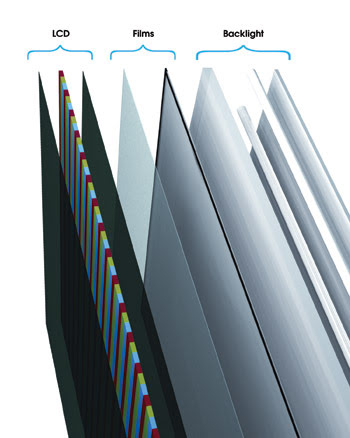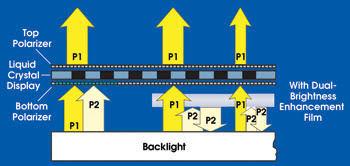Brightness-enhancement films are used in novel ways to overcome challenges posed by larger, brighter displays.
William K. Smyth, 3M Optical Systems Division
Consumers plan to purchase 72 million LCD TVs in 2007 and 98 million in 2008, when sales will surpass cathode-ray tube TV unit sales for the first time, according to the research firm DisplaySearch of Austin, Texas. The industry is racing to build appliances to meet the demand and to deliver the stunning picture quality that buyers expect.
Today, consumers want large LCD TVs with full-high-definition progressive scan, wide color gamut and fast response times. Full high definition is defined by a resolution of 1920 × 1080 pixels. There are two types of full high definition: interlace technology, or 1080i, which creates a picture on an every-other-line basis, and progressive scan, or 1080p, which paints the picture on a line-by-line basis. Most full-high-definition LCD TVs are progressive scan.
The light-sapping technologies that deliver better images and performance include 1080p, wide-color-gamut TVs, and vertically aligned and in-plane switching liquid-crystal modes. Vertically aligned and in-plane switching deliver faster response times and wider viewing angles. The technologies that enable improved images, however, also reduce the amount of light transmitted through the LCD panel. This means that more energy is required to produce the same brightness. To eliminate the energy drain, manufacturers use an optical film that recycles the light that would have been wasted, allowing high-performance LCD TVs to deliver equal brightness with less energy.
Full high definition
The rapid growth of LCD TV sales is driven by lower prices, better performance and digital mandates that require broadcasters to use digital signals exclusively. In the US, consumers will need a digital TV or a converter box after February 2009.
Consumers also want high-resolution images, making LCD TVs with 1080 lines of resolution — full high definition — a popular format. High-definition LCD TVs with 720 lines of resolution (720p) are also available, but DisplaySearch forecasts that 1080p will be 25 percent of the market by 2010.
However, there is a 25 percent reduction in light transmission in 1080p compared with 720p because 1080p has greater pixel density — meaning more pixels per square inch — and the width of the black matrix surrounding each pixel remains the same as the pixel shrinks. So as the number of pixels increases, a greater percentage of each pixel is black. To maintain equal brightness and picture quality in LCD televisions with greater pixel density, manufacturers can use a 3M reflective polarizing film to recycle existing light, add bulbs or increase the power to existing bulbs.
Enhancing color
To enhance color performance, manufacturers are turning to wide-color-gamut cold-cathode fluorescent lamps, a high-performance version of the cold-cathode fluorescent lamp bulbs commonly used in LCD backlights.

Figure 1. The backlight provides a bright, uniform light source. The optical film optimizes the light, while the LCD works as a light valve.
Wide-color-gamut bulbs have an improved emissions spectrum that can increase color space by approximately 28 percent over standard cold-cathode fluorescent light sources. The bulbs add vivid color to enhance the overall viewing experience but are approximately 30 percent less efficient than standard cold-cathode fluorescent bulbs.
DisplaySearch estimates that more than 40 percent of TVs sold in 2008 will contain these bulbs, and the percentage of wide-color-gamut LCD TVs larger than 30 in. is expected to grow rapidly for the foreseeable future.
To improve contrast, viewing angles and response time, the industry is moving to vertically aligned and in-plane switching liquid crystal modes in LCD TVs. At one time, most LCDs used twisted nematic liquid crystal structures, but these were initially used in applications where limited viewing angles were acceptable, such as mobile phones and computer displays.
New in-plane switching and vertically aligned modes offer improved switching speeds, contrast and viewing angles. Both provide significant performance advantages over twisted nematic LCD TVs, but the technologies also transmit 50 percent less light; hence, the need for brighter backlights or films that recycle light.
Approximately 84 percent of LCD TVs will be vertically aligned or in-plane switching modes in 2008, according to DisplaySearch.
Energy savings
New technology such as larger LCD televisions, 1080p and other light-sapping advances add up to televisions requiring more energy. According to the US Energy Information Administration, TVs consumed 6 percent of US residential energy in 2005 and, by 2010, they will consume 7 percent. Voluntary standards such as Energy Star aim to reduce US energy use in TVs and other products. In the future, mandatory standards are likely to emerge as governments worldwide enact tighter regulations to help reduce greenhouse gas emissions.
Television manufacturers are working to reduce the energy their products consume, and optical films are helping them meet the design challenges created by tightening energy standards and technologies that lower light transmission.
For example, 3M’s Vikuiti dual-brightness-enhancement film increases the efficiency of LCD TVs by 20 to 30 percent. A reflective polarizer, it recycles light that would otherwise get absorbed by LCD polarizer films. By improving light management, the film enables bright screens that require less energy and fewer bulbs to achieve a given brightness.

Figure 2. The Vikuiti dual-brightness film works through polarization recycling. This diagram shows a conventional backlit system emitting P1 and P2 light. A typical polarizer absorbs P2, but the film reflects P2 into the backlight, where it is recycled into P1 and P2. More P1 light is then available to be transmitted through the LCD.
Meanwhile, manufacturers are investing billions of dollars to increase production capacity to meet anticipated demand of more than 400 million LCD TVs in the next four years. They produce motherglass for LCD panels in large sheets before processing it into smaller sizes. The sizes of these sheets have had to grow as demand for larger TVs has increased. The increases in glass size are marked in generations, or “gen.” For example, Sharp’s Gen 8 motherglass measures 2160 × 2460 mm and is <1 mm thick and, from this, Sharp can make eight 46-in. TVs or six 52-in. ones. Sharp started production on its Gen 8 plant last fall, Samsung is expected to begin Gen 8 production this summer with a motherglass size of 2200 × 2500 mm, and others are expected to follow. Demand for the LCD panels used in TVs, computer monitors, notebook and handheld displays amounts to a growth rate of 10 to 15 million square meters per year.
Meet the author
William K. Smyth is senior manager of marketing and business development at 3M Optical Systems Div. in St. Paul, Minn.; e-mail: [email protected].